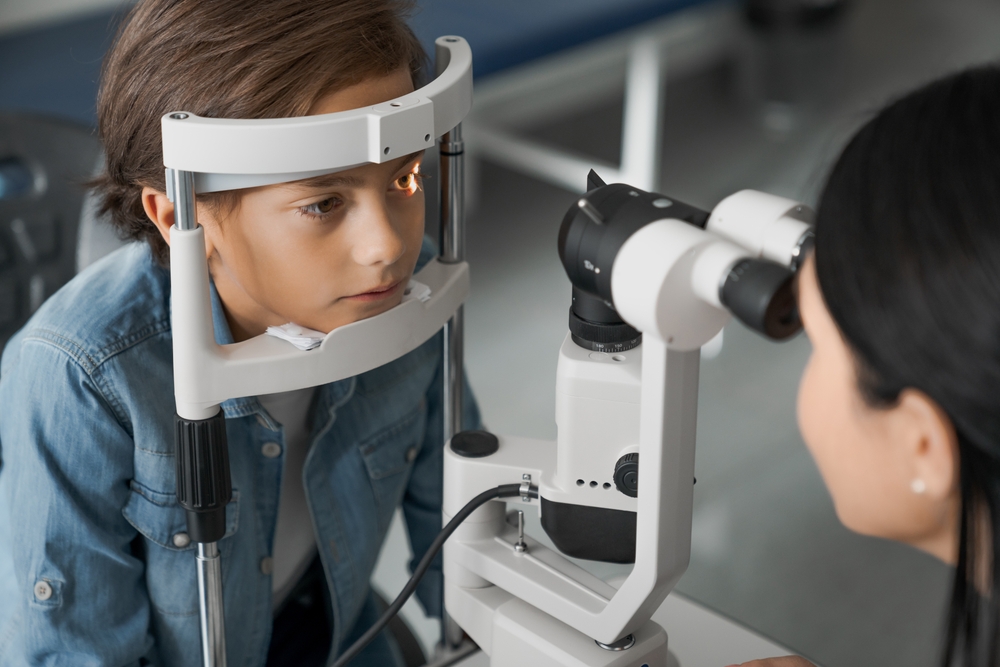Address:
26400 Kuykendahl Rd. Suite A190
The Woodlands, TX 77375

Myopia is on the rise globally, with the World Health Organization estimating that by 2050, nearly 50% of the world's population will be myopic. This increase is largely attributed to lifestyle changes, such as increased time spent on digital devices and less time spent outdoors. Understanding myopia in children is crucial, as it can have significant implications for their visual development and overall eye health.
Myopia, also known as nearsightedness, is a common refractive error that affects the way the eye focuses light. In myopic eyes, the eyeball is slightly longer than normal, causing light to focus in front of the retina instead of directly on it. This results in blurred distance vision, a condition that typically begins in childhood and often progresses as the child grows.
The most common signs of myopia in children include difficulty seeing the board or objects in the distance, squinting or closing one eye to see better, and frequent headaches or eye strain. Children with myopia may also exhibit behavioral changes, such as sitting closer to the television or holding books and electronic devices very close to their eyes.
If you notice any of these signs in your child, it's essential to schedule a comprehensive eye exam with an optometrist. Early detection and intervention are key to managing myopia and preventing it from progressing further.
Regular pediatric eye exams play a crucial role in the early detection and management of myopia in children. The American Optometric Association recommends that children have their first comprehensive eye exam at 6 months of age, followed by additional exams at 3 years old and 5 years old. After that, children should have an eye exam every year or as recommended by their eye care provider.
During these exams, eye doctors can measure the child's refractive error, assess their visual acuity, and identify any signs of myopia or other vision problems. By catching myopia early, your doctor can implement effective treatment strategies to slow its progression and protect the child's long-term eye health.
Myopia management in children is essential for several reasons. First, uncorrected or unmanaged myopia can lead to more severe vision problems later in life, such as retinal detachment, glaucoma, and cataracts. Additionally, myopia has been linked to an increased risk of other ocular conditions, including macular degeneration and myopic maculopathy.
Myopia can also have a significant impact on a child's quality of life, affecting their academic performance, sports participation, and overall confidence. By proactively managing myopia, you can help ensure your child's visual development and overall well-being.
One of the most effective treatments for myopia in children is the use of atropine eye drops. Atropine is a medication that works by temporarily paralyzing the eye's focusing mechanism, which can slow the progression of myopia. Studies have shown that low-dose atropine eye drops can reduce the rate of myopia progression by up to 60% in children.
Another effective myopia management option for children is the use of MiSight 1 Day soft contact lenses. These specialized contact lenses are designed to slow the progression of myopia by altering the way light enters the eye. MiSight 1 Day lenses have been shown to reduce myopia progression by up to 59% in children aged 8 to 12 years.
One of the key advantages of MiSight 1 Day lenses is their convenience. Unlike traditional contact lenses, which require daily cleaning and maintenance, MiSight 1 Day lenses are designed to be worn for a single day and then discarded. This makes them an easy and hassle-free option for children and their families.
Orthokeratology, or Ortho-K, is a non-surgical approach to myopia management that involves the use of specially designed rigid gas-permeable contact lenses. These lenses are worn overnight and temporarily reshape the cornea, the clear front part of the eye, to improve visual acuity during the day. The lenses work by gently reshaping the cornea, which can reduce the eye's overall length and prevent further myopic changes. Ortho-K is a reversible treatment, meaning that when the lenses are removed, the cornea returns to its original shape.
As the prevalence of myopia continues to rise, the importance of effective myopia management in children has never been greater. By recognizing the signs of myopia, scheduling regular pediatric eye exams, and exploring the various treatment options available, you can help ensure your child's visual development and overall eye health.
At Creekside Family Eyecare, we can help you identify and manage myopia in your child, ensuring they have the best possible vision and eye health. Visit our office in The Woodlands, Texas, or call (832) 559-3861 to schedule an appointment and learn more about our myopia management services.